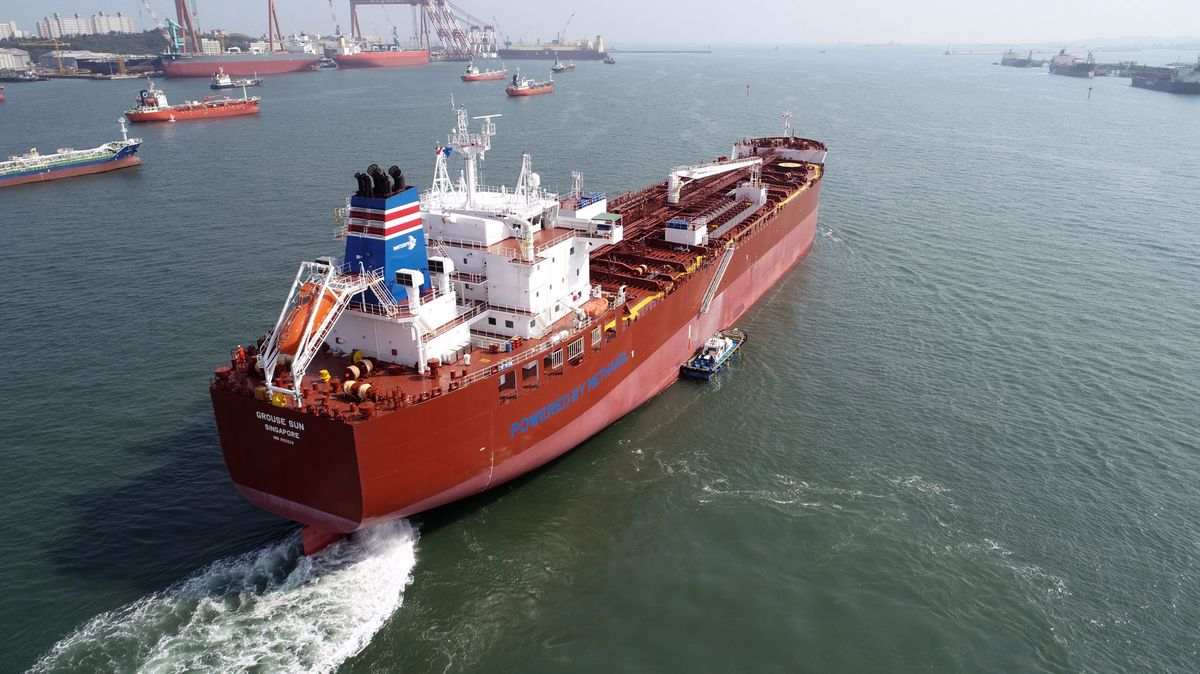The Week in Alternative Fuels
Here are some of the key developments in alternative bunker fuels from the past week.
 PHOTO: NYK's dual-fuelled chemical tanker Grouse Sun. NYK
PHOTO: NYK's dual-fuelled chemical tanker Grouse Sun. NYK
MOL Chemical Tankers has teamed up with bunker supplier TFG Marine to explore how its operated tankers can be supplied with biodiesel in bunker ports around the world.
Egypt's Suez Canal Economic Zone has signed an agreement worth $3 billion to produce 350,000 mt/year of green hydrogen and ammonia for bunkering in the Port of Ain Sokhna.
NYK Bulkship Asia has inducted the methanol-fuelled chemical tanker Grouse Sun, which was built at the South Korean Hyundai Mipo Dockyard.
A European consortium plans to invest €1 billion in the MadoquaPower2X complex in Portugal's Port of Sines, targeting an annual production of 500,000 mt of green ammonia and 50,000 mt of green hydrogen by 2030.
Japanese shipbuilder Kawasaki Heavy Industries received an order from shipping company NYK Line to build an 86,700 cbm LPG-ammonia carrier that can run on LPG and VLSFO.
Shipping classification society DNV says non-combat naval ships can take up alternative fuels as they have fewer operational restrictions than naval ships sent into combat.
Caribbean LNG looks to develop a MiniLNG terminal on Antigua that will receive LNG from smaller vessels supply it as bunkers in the future.
Sweden's Port of Kapellskär near Stockholm aims to connect Finnlines ferries to shore power by next year.
Here are the top five stories in alternative fuels this week:
MOL, TFG Marine to develop global biodiesel bunker supply network
MOL Chemical Tankers has teamed up with bunker supplier TFG Marine to explore how its operated tankers can be supplied with biodiesel in bunker ports around the world.
MOL Chemical Tankers, a wholly owned subsidiary of Japanese shipping company Mitsui O.S.K. Lines (MOL), has already trialled biodiesel supplied by TFG Marine. Its Niseko Galaxy was fuelled with 200 mt of biodiesel from TFG Marine last month on a voyage to the US Gulf Coast.
The diesel engine requires no modifications to consume the biodiesel, which was made up of 30% biodiesel and 70% conventional heavy fuel oil.
Egypt signs agreement to produce green ammonia for Ain Sokhna bunkering
Egypt's Suez Canal Economic Zone has entered the pact with a consortium that includes EDF Renewables, a subsidiary of French utility company Electricite de France (EDF), the Sovereign Fund of Egypt and the Zero-Waste Egypt Alliance.
The first phase of the project will launch in 2024. Green hydrogen production capacity will initially be 140,000 mt/year and target bunker demand, and then be ramped up to 350,000 mt/year by the first quarter of 2026.
Egypt has also signed a separate agreement with AMEA Power, a subsidiary of the Emirati Al Nowais Group, to produce green ammonia in Ain Sokhna with a production capacity of 240,000 mt/year in the first phase.
Last month, four Egyptian authorities signed agreements with A.P. Moller-Maersk to explore prospects for scaling up green fuel production in the country.
NYK Bulkship inducts another methanol-fuelled chemical tanker
The 31,000 mt gross tonnage vessel was delivered on 19 April and is the second of two chemical carriers to be chartered by chemicals transporter Waterfront Shipping from NYK Bulkship. The charter was announced in December 2020.
The first of these methanol-ready dual-fuel tankers was delivered in January.
They vessels can run on either methanol or heavy fuel oil. When powered by methanol, nitrogen oxide (NOx) emissions can be reduced through adding water to cool the fuel during combustion.
European consortium to invest €1 billion in green ammonia complex in Portugal
Hydrogen and ammonia produced from the planned MadoquaPower2X complex will primarily be consumed in the domestic Portuguese market, while surplus product could be exported from the Sines port terminal.
The complex aims for an annual production of 500,000 mt of green ammonia and 50,000 mt of green hydrogen by 2030.
The project is currently under review and awaits a final investment decision that is expected by end of 2023. If the project moves ahead, the group aims to start building the plant in 2024 and commission it by 2030.
NYK Line orders third LPG-ammonia carrier
Japanese shipbuilder Kawasaki Heavy Industries received an order from shipping company NYK Line to build an 86,700 cbm LPG-ammonia carrier that can run on LPG and VLSFO.
The vessel will have two separate storage tanks to carry LPG and ammonia.
Kawasaki says the vessel’s shaft generator will be able to convert kinetic energy from the main engine to electricity, which can provide an alternative to onboard diesel generators.
The shipbuilder aims to deliver the vessel to NYK Line by 2024. It will be NYK Line's third LPG-ammonia carrier.
Kawasaki has a total of six these vessels in its order book.





